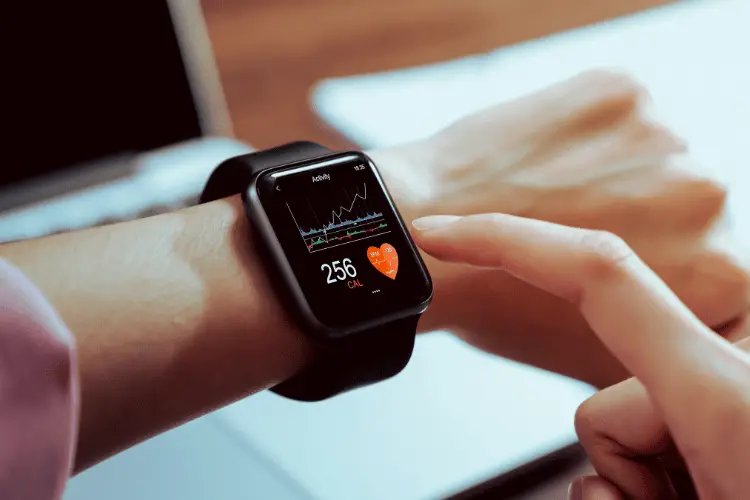When you’ve just entered the world of fitness, you may struggle to keep up with all the statistics and parameters concerning your health. Should you only watch your calorie count, heart rate, sleeping patterns, and blood pressure, or is there more?
With some digging, you’ll uncover even more stuff that you need to monitor that may have escaped your thought at first. How do you make sure you’re tracking all the statistics you should be keeping on your own fitness and health if they’re too many?
Well, this comprehensive guide is here to give you a hand. Below, we’ll share with you all the important data you should be regularly checking regarding your fitness performance, essential health metrics, and even personal goals.
With everything you need all in one place, there should be no room for confusion. So, let’s get right to it!
Statistics and Data About Your Fitness Performance
First and foremost, you’ll want to keep track of how your fitness levels progress over weeks and months. This data won’t only significantly boost your confidence, but it’ll also help you reach your fitness goals and push yourself further.
This all starts with an exercise log. Just keep track of the day-to-day exercises you do. The more detailed, the better. This can be referred to and used in a ton of different ways. Whether you’re trying to find out why you aren’t growing muscle or if a concerning medical condition comes up, you can show your log to a doctor to give them a perfect picture of your physical activity levels.
That counts for a lot.
It also helps just to look back and see that you haven’t been slacking. Personally, I’m pretty hard on myself so it is good to look back and see what I’ve done and the progress made.
1. One-Mile Run
Running is one of the easiest things to track. Start a stopwatch and run like there are zombies chasing you.
Whether you’ve been running for a while or you’ve just started, recording data about your runs, especially one-mile runs, can give you plenty of insight into your own fitness. A seasoned runner will also benefit from this information if they’re gearing up to run a marathon or a half-marathon.
To measure your performance on a one-mile run, the most important parameter to watch out for is time. Try not to complicate it with a bunch of hills. Just pick a flat route and map it out with Google Maps or use one of the thousands of fitness apps out there.
For example:
- A beginner is expected to run one mile in around 12–15 minutes.
- On the other hand, a noncompetitive, somewhat experienced runner usually covers the same distance in around 9–10 minutes.
- Impressively, an elite runner can run a mile in 5 minutes, if not less!
Of course, these numbers are averages, as they’re highly affected by other factors that vary from one person to another. Besides skill level, how long it takes you to run a mile depends on your age and sex.
Here’s a table that highlights the average number of minutes that each sex can run per mile (based on a study on male and female participants during a 5K race):
| Age group | Men (minutes in a mile) | Women (minutes in a mile) |
| 16–24 | 9:30 | 12:00 |
| 25–34 | 10:06 | 12:00 |
| 35–44 | 10:30 | 12:20 |
| 45–54 | 11:00 | 13:00 |
| 55–59 | 12:08 | 14:37 |
| 60–64 | 13:05 | 14:47 |
| 65–99 | 13:52 | 16:12 |
Even though the most relevant piece of information you should monitor during a one-mile run is time, your pacing and heartbeat can be equally enlightening. Thankfully, you can keep track of those using a dedicated fitness tracker or smartwatch.

2. 5K Run
Next up, you can keep tabs on your 5K run time. The parameters you should watch for are similar to one-mile runs, but here, they’re stretched over a distance of 3.1 miles.
First off, you should start by running your first 5K.
Knowing this data is crucial if you’re preparing for an upcoming 5K, training for a 10K, or gearing up for a half-marathon or full-fledged marathon. By monitoring your mileage weekly, you should be able to estimate how long it’ll take you to run the race, not to mention improve your endurance, too.
Here are a few eye-opening statistics about how different skill levels perform in 5K runs:
- A person who’s been training regularly can run a 5K in 26–36 minutes.
- A runner that jogs for the entirety of a 5K race at 10 minutes/mile is likely to finish it in as little as 30 minutes.
- People who do jogging and walking intervals can run a 5K in around 35–40 minutes.
- A beginner is inclined to complete a 5K distance in 40 minutes.
3. 10K Run
Even more than a 5K run, tracking your 10K is the best way to judge your performance on a half-marathon or marathon. Besides your mileage, keep your pacing, breathing patterns, and jog/walk intervals in mind to better prepare for a longer race.
If you’re wondering, this is how long it takes to run a 10K in different situations:
- A fit runner can finish a 10K in around 60 minutes.
- A more advanced runner is likely to run a 10K in 45 minutes.
- Elite runners can cover a 10K distance in as less as 30 minutes!
4. Deadlift
If you prefer to spend time in the gym, deadlifting could be one of your favorite exercises. This demanding move does wonders for the shape and strength of your muscles, which is why you should work hard to master it.
The variables that you should track regularly when deadlifting include the number of reps and sets and the weight you’re lifting. Here’s what you can expect at different skill levels:
- The average beginner-level male can lift around 155 pounds, which can rise to 285 pounds in a single rep after training for 3 months.
- Intermediate-level males can lift up to 324 pounds, while pros are likely to lift 348 pounds (varies according to weight class and age).
- A beginner-level woman is able to deadlift 84 pounds. This weight should ideally increase to 132, 193, 265, then 345 pounds with continuous training.
Most importantly, you should constantly watch your form and technique to eliminate the risk of cramps, strain, and injuries.
5. Max Bench Press
Doing bench presses may be another strength training exercise that you like to do, and monitoring your bench press one-rep max is the right way to judge your progress in this workout.
Basically, 1RM refers to the max amount of weight you’re able to bench press for a single rep through a full range of motion with proper posture and technique. You can easily calculate your 1RM using a bench press calculator!
Just enter your weight and number of reps, and the tool will show you your 1RM as well as the estimated number of reps at different percentages of your 1RM.
6. Back Squat Max Lift
Last but not least, it’s always a good idea to get regular insights into your back squat max lifts. Much like the previous exercise, knowing how much you’re able to squat and watching your progress can help you perfect your physique.
- On average, a male beginner should be able to lift 141 pounds, a novice 206 pounds, an intermediate 287 pounds, and an elite 483 pounds.
- Alternatively, a beginner female squatter is likely to lift 65 pounds. With training, this weight can go from 107 all the way to 300 pounds!
Statistics and Data About Your Health Metrics
What should be on your mind next are a few details regarding your health. Things like your blood pressure, resting heart rate, body fat percentage, and more are important to check regularly to ensure you’re always in tip-top shape.
Monitoring these metrics is even more crucial for people with certain diseases like diabetes, high blood pressure, heart disease, etc. So, let’s take a look at a few measures of health that you need to track.
Blood Pressure
High blood pressure can contribute to many cardiovascular diseases, which is why you have to check it on a yearly basis.
Try to aim for 120/80 or lower.

Cholesterol
Keeping your cholesterol in check equals low risks of heart strokes and heart attacks. Therefore, regular blood tests that measure cholesterol are a must every year, especially if high cholesterol runs in the family, as it’s hereditary.
Make sure that it doesn’t go over 100 mg/dL LDL.
Resting Heart Rate and Heart-Rate Variability
Another health indicator you should be monitoring is your resting heart rate, which is the number of heartbeats per minute. Unlike the previous factors, you should track your resting heart rate daily, as it’s a straightforward way to keep your circulatory system’s well-being in check.
Here, a good resting heart rate is 60–100 bpm, although athletes should expect that number to be in the 50s or even 40s. A reliable fitness tracker can easily monitor this one for you!
Similarly, your heart-rate variability should be tracked every day, as it measures the variation in time between heartbeats. Knowing this information tells you a lot about how stressed you are, as the higher the number is, the more relaxed and fit you are.
Generally, anything over 50 milliseconds is preferable.
Number of Hours Slept at Night
Next up, you should take note of the number of hours you sleep each night because research has found that the better you rest at night, the healthier you are in many ways. Think along the lines of increased productivity, physical activity levels, etc.
Many fitness trackers are designed to give you a detailed breakdown of your time in bed, including your sleeping patterns and REM time. Keeping those factors in mind and trying to improve their numbers can significantly enhance your sleep quality.
Body Fat Percentage
A great way to better judge whether or not your weight is healthy, especially if you’re packing on muscle, is to use a smart body fat percentage scale. That’s because a normal scale shows you the overall body mass, so it takes the muscle into account as well as fat.
Ideally, aim for a body fat percentage of 6–17% and track your numbers on a monthly basis.
Blood Sugar
It’s important to test your blood sugar yearly as it reveals risks for diabetes, heart attack, and more.
70–99 milligrams per deciliter are good numbers, while anywhere from 100–125 is prediabetic.
Testosterone Levels
If someone has low testosterone levels and has undergone treatment to bring them up, they should start monitoring them every 3–6 after treatment.
Usually, in these cases, the target range is 350–750 ng/dL.
Basal Metabolic Rate
The Basal Metabolic Rate is the number of calories you burn when you simply go about your day as normal (without doing intense physical activity). A lot of people like to keep tabs on this health metric, too, as it helps them understand how their bodies lose weight.
A normal BMR for an average man is 1,600–1,800 kCals, while it’s typically around 1,550 kCals for most females.
Statistics and Data About Your Personal Goals
Last but not least, you can include all sorts of personal goals as part of your tracking routine to check along with the previous parameters. Any fitness goal that you have is worth monitoring to make adjustments and improvements and see how far you’ve come.

To Wrap It Up
The statistics you should be keeping on your fitness and health are endless, but those that I included in this article are the most important you should keep in mind.
Of course, the more familiar you are with your fitness level and the more exercises you add to your routine, the more parameters you’ll find yourself wanting to track. No matter what you choose to monitor, you’ll always have my approval because that’s the key to improvement and success!
Resources
- https://www.nifs.org/blog/7-reasons-to-track-your-fitness-progress
- https://marathonhandbook.com/whats-a-good-mile-time/
- http://www.pace-calculator.com/5k-pace-comparison.php
- https://www.mayoclinic.org/healthy-lifestyle/fitness/in-depth/5k-run/art-20050962#:~:text=Start%20with%20a%20slower%20pace,30%20minutes%20at%20a%20time.
- https://www.runnersworld.com/training/a20817651/your-first-10k/
- https://www.shape.com/fitness/training-plans/how-train-half-marathon-beginners
- https://www.rei.com/learn/expert-advice/training-for-your-first-marathon.html
- https://marathonhandbook.com/how-long-does-it-take-to-run-a-5k/
- https://www.cosmopolitan.com/uk/body/fitness-workouts/a32378723/average-time-run-5k/
- https://www.verywellfit.com/how-long-will-it-take-to-run-a-10k-2911115
- https://www.medicalnewstoday.com/articles/what-muscles-does-deadlift-work
- https://outlift.com/how-much-can-the-average-man-lift/
- https://powerliftingtechnique.com/how-much-should-you-deadlift/#:~:text=The%20average%20deadlift%20for%20a%20male%2020%2Dyear%2Dold%20is,209lb%20to%20337lb
- https://strengthlevel.com/strength-standards/deadlift/lb#:~:text=very%20impressive%20lift.-,What%20is%20a%20good%20Deadlift%3F,normally%2020%20kg%20%2F%2044%20lb.
- https://www.youtube.com/watch?v=r4MzxtBKyNE
- https://strengthlevel.com/strength-standards/squat/lb
- https://behaviorfit.com/4-reasons-why-you-should-monitor-your-health-and-fitness-data/
- https://www.mayoclinic.org/diseases-conditions/high-blood-pressure/symptoms-causes/syc-20373410
- https://www.bhf.org.uk/informationsupport/heart-matters-magazine/medical/tests/blood-cholesterol#:~:text=The%20higher%20your%20cholesterol%2C%20the,it’s%20important%20to%20get%20tested.
- https://www.mayoclinic.org/healthy-lifestyle/fitness/expert-answers/heart-rate/faq-20057979#:~:text=A%20normal%20resting%20heart%20rate%20for%20adults%20ranges%20from%2060,to%2040%20beats%20per%20minute.
- https://my.clevelandclinic.org/health/symptoms/21773-heart-rate-variability-hrv#:~:text=What%20is%20heart%20rate%20variability,undetectable%20except%20with%20specialized%20devices.
- https://www.ncbi.nlm.nih.gov/pmc/articles/PMC6281147/#:~:text=Newer%20studies%20are%20strengthening%20known,dementia%2C%208%2C9%20and%20even
- https://www.cdc.gov/diabetes/managing/managing-blood-sugar/bloodglucosemonitoring.html
- https://www.issaonline.com/blog/post/setting-fitness-goals-is-essential–to-long-term-success
- https://toughmudder.com/blog/no-excuses/how-to-train-for-toughest-mudder-according-to-ryan-atkins/


